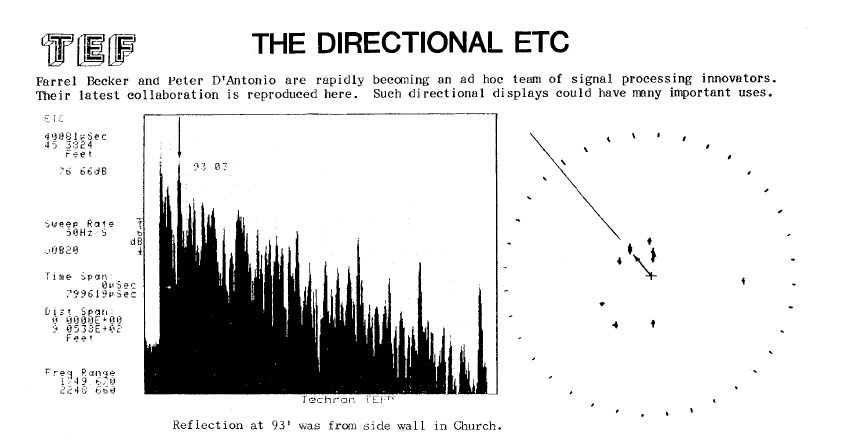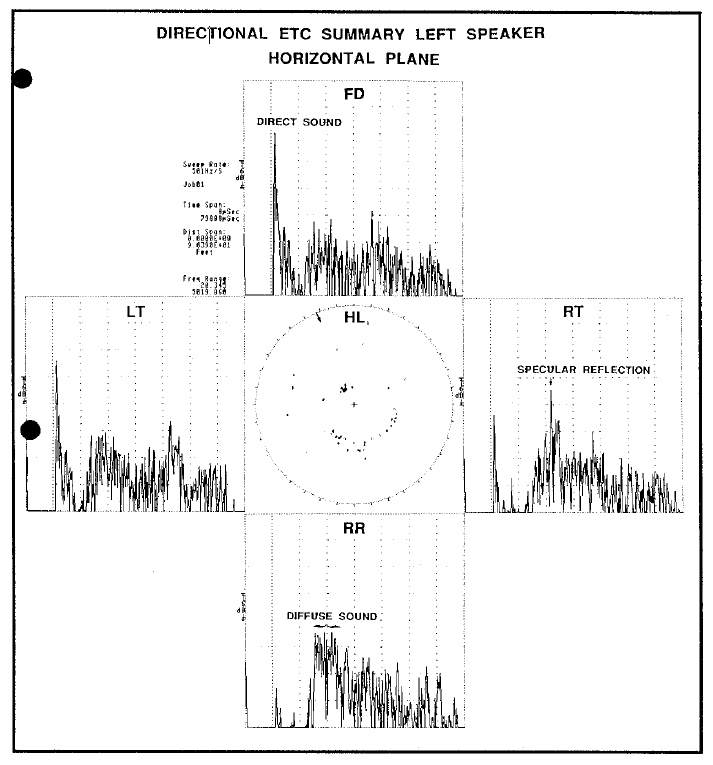At the end of the 80s, even before the application of any Ambisonics or Spatial Audio technique for identifying the direction of reflections and echoes, Farrel Becker and Peter Dantonio, determined directional ETC measurements capable of identifying the origin of a reflection.
Peter Dantonio, John Konnert, together with Charles Bilello and Farrel Becker, published a paper on the topic: “Sound Intensity Measurements and Interaural Cross Correlation Measurements using Time Delay Spectrometry”.
Time delay spectrometry and TEF were used for collecting binaural measurements.

The subjective binaural perception of a space is determined by the magnitude, direction and arrival time of the direct sound and indirect reflections from surface boundaries.
Hence, it is important to be able todetermine the intensity of all sound
sources in a room and cross correlate the measurements at each ear .
Intensity measurements were made with the TEF analyzer using six
orthogonal measurements with a cardioid micorphone sensitivity
pattern and processed using the POLAR-ETC program of Becker.
Polar ETC plots indicate the arrival time and direction of the direct sound and all room reflections, within a certain time range, at a particular threshold below the level of the direct sound. The interaural cross correlation measurements were made with the TEF analyzer using
Knowles microphone embedded in the pinnea of each ear of a “live”
subject. Each ear microphone was connected to a separate Techron
TEF analyzer and both were triggered simulataneously. The time
responses at each ear were correlated over 1 ms using a new lACC
program by D’Antonio.


In the following photo, portraying a TEF CLASS by SynAudCon, a young engineer Douglas Jones Jones placing Knowles microphones for Interaural Cross Correlation measurements in the ears of poor Charles Bilello. In the background a quite almost amused Peter Dantonio.

Doug Jones writed:
It is quite exciting to see Peter D’Antonio taking
a slightly new course in writing TEF software
and doing work in interaural cross correlation.
I would like to be able to peiform these sorts of
meaurments in control rooms whose “imaging
ability” is known to be good, then compare them
with measurements taken in rooms with poor
imaging.
As to the question of where to place the
microphone during measurements of this sort, it
is beginning to look like the best place is at the
ear drum. Some of the recent work that Bill
Martens is doing points in this direction. It is
clear from what we know already that the complete
Pinnea should be included in the picture.
The question is what to do with the ear canal.
There are really two choices 1) i fill it up so it is
out of the picture. and risk loosing some poten-..
tially interesting information, or 2) use a probe
tube microphone. The use of probe tubes raises
a whole new set of problems,. not the least of
which is calibration and repeatability.’ Wefeel
that the only practical way with live subjects is
to occlue the ear canal with waxy cotton (such
as F lents) and press the microphone capsule into
the wax so that the suiface of the mic is flush,
with the wax and is at the entrance of the ear
canal. Of course if you are fortunate enough to
have Kemar then one can compare measurments
taken at each position.
Images are courtesy of SynAudCon